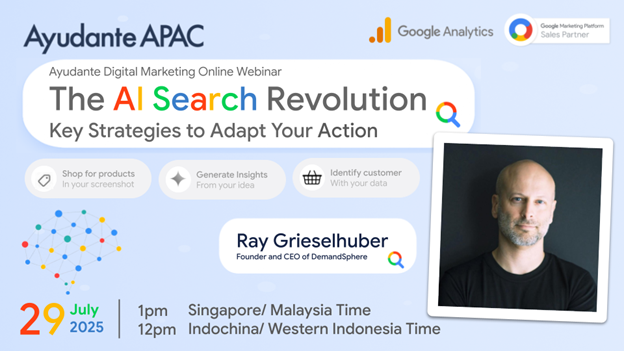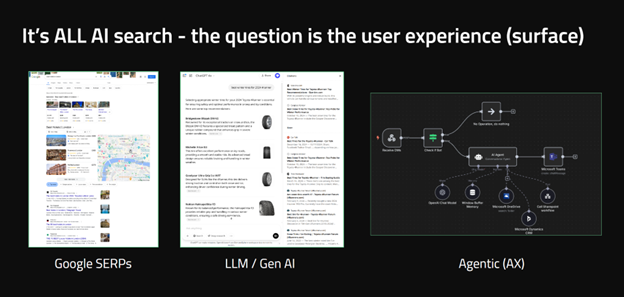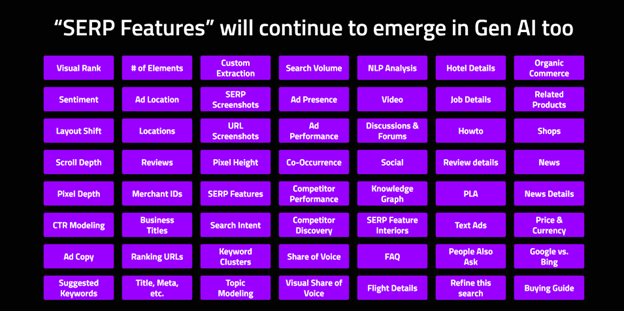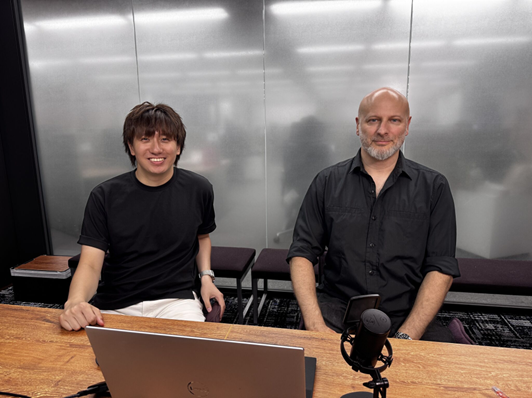


On 29 July 2025, we had the pleasure of hosting a webinar at Ayudante APAC, exploring how AI is changing the landscape of search.
I had the honour of facilitating the session, joined by a very special guest: Ray Grieselhuber, founder of DemandSphere, and an insightful voice in technical SEO and AI-driven search.
Ray’s session struck a perfect balance between strategic perspective and hands-on guidance. He offered clarity on a topic that’s often surrounded by hype, and challenged us to rethink the way we measure success in this new environment.
One moment in particular stood out — a quote that felt both timely and telling:
“There is no more traditional versus AI search. It’s all AI search."
This wasn’t just a soundbite. It was a wake-upcall.

Ray began with a clear message: AI in search is not something that’s coming in the future. It’s already here, built into nearly every major platform. Whether we’re using Google Search, ChatGPT, Gemini, or Perplexity, AI now plays a central role in how information is found, displayed, and ranked.
Rather than drawing a line between “traditional” search and “AI” search, Ray suggests that we shift our focus to the surfaces, the places where users actually engage with search results.
“Everything is AI search. The question is not whether AI is involved. It’s what kind of surface the user is interacting with."
He highlighted three main surfaces we should be paying attention to:

One of the strongest messages from Ray’s talk was the need for a shift in mindset. Traditionally, marketers have measured success through traffic and click-through rates. But those numbers no longer tell the fullstory.
“Clicks, impressions, conversions. They are all downstream of attention."
This attention-first framework is crucial in an era of AI Overviews and zero-click searches. Ray explained how SERP (Search Engine Results Page) features such as featured snippets, FAQs, product cards and AI panels now dominate the screen, drawing users’ eyes away from the standard blue links.
He introduced the idea of SERP shape analysis, a method for understanding not just where you rank, but how your presence is visually structured. Metrics like pixel depth and visual rank reveal whether a listing is truly visible or effectively buried.
In one example, a site ranked fifth organically but appeared 2,100 pixels down the page, well below the fold. And yet, thanks to its appearance in an AI Overview, it still achieved a 33% click-through rate.

A core theme throughout the session was the need to combine multiple datasets to build a more accurate picture of what users are seeing and doing.
Ray encouraged marketers to look beyond Google Search Console and integrate data from the SERP (Search Engine Results Page) itself. This includes understanding where AI-generated content appears, which features capture attention, and how often your brand is mentioned.
“If you’re only looking at your average position, you’re missing the point. Visibility now happens within the SERP.”
This approach, known as Unified Visibility, helps answer questions like:
These insights are essential not just for SEO, but also for brand strategy, content development and executive reporting.
Ray shared a number of practical tips that resonated deeply with our audience:
He also reminded us that most generative engines like ChatGPT still depend on traditional search indexes. So if you rank well in Google, you still have a real opportunity to be surfaced by AI engines.
The questions from the audience were some of the best we’ve received in any webinar to date. A few highlights included:
Q: Will AI search make it harder for small websites to compete?
Ray: Yes, large brands are favoured. But smaller players can still win with niche content, speed and creativity. Focus on appearing in traditional search and let that visibility carry forward into AI contexts.
Q: How should we balance SEO with AI Engine Optimisation (AEO)?
Ray: Both matter. Clicks aren’t going away. But you need to track impressions, citations, and visibility too. These are all signals of attention. And attention is the new currency.
Q: Is SEO going to die?
Ray: I’ve been in this space for 18 years. SEO dies every year and then comes back stronger. What’s really happening is SEO is evolving into AEO. It’s not the end — it’s the next chapter.
Q: What tools should we use to track AI mentions of our brand?
Ray: Use your own prompt testing. Some platforms, including ours, can track AI citation visibility across ChatGPT, Gemini and Perplexity. But even basic queries can give you a clear picture of where your brand appears and how it’s described.

If there’s one key takeaway from this session, it’s this:
We can no longer separate AI from SEO.
Search today is powered by AI by default. Andt hat changes everything. It’s not just about how results are generated, but how we plan, measure, and report success. Traditional SEO metrics like rankings and traffic still matter, but they are no longer enough. It’s now also about whether your content is being seen, cited, and trusted across multiple platforms.
Even in this AI-driven landscape, measurement remains the foundation. Tools like Google Analytics and Search Console are essential for understanding visibility, modeling attention, and making data-informed decisions.
At Ayudante, our international SEO team is here to help you adapt. Whether you're refining your Google Analytics setup, exploring prompt research, or building unified reporting frameworks, we’re ready to support you.
A heartfelt thank you to Ray Grieselhuber for his brilliant insights, and to everyone who joined us live. With over 300 attendees, this was our (so-far) most registered webinar of the year.
Let us keep learning together and continue building smarter, more accurate, and more human digital strategies for the AIera.
